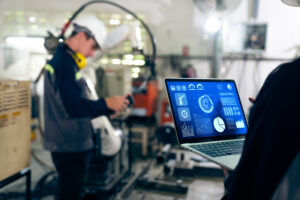
In today’s digital world, the concept of a “digital twin” has become a hot topic. But what exactly is a digital twin, and how does it work? Digital Twins in manufacturing are becoming increasingly popular as a way to optimize processes and reduce costs. These virtual replicas of physical machines, components, and other assets provide real-time data to help manufacturers make better decisions.
Although the concept of digital twins has been around for decades, the technology has only recently become widely available. This blog post will provide an overview of digital twins in manufacturing, including benefits and impact.
What are Digital Twins
Digital twins are a powerful smart manufacturing tool that supports production.
A digital twin is the creation of an identical virtual product or system before a physical prototype is manufactured.They are used to simulate and predict how the physical object will behave in different conditions or scenarios. This allows manufacturers to test out new designs, optimize existing ones, and monitor performance in real-time.
While they have technically been in use since the 1960s – NASA used a model of one of their space craft on the Apollo 13 mission –the concept of digital twins was first developed in the early 2000s by researchers at the Massachusetts Institute of Technology (MIT). The goal was to create a digital representation of physical objects that could be used for simulation, analysis, and optimization. The technology has since been adapted to many different industries, but it is particularly useful in manufacturing.
The research company Gartner put digital twins as part of the top 10 strategic trends from 2017 and estimated that by 2020 there would be billions of processes related to this technology. In addition, according to Markets and Markets, the market related to the generation of digital twins is estimated to grow to 35. 8 billion in 2025.
How do Digital Twins Work
Simply put, a digital twin is a digital representation of a physical object, system, or process. It’s a virtual model of the real-world entity that can be used to monitor or control its physical counterpart. This model is created using data gathered from sensors, software, and other sources.
The power of digital twins comes from connecting real-world assets with real-world data, so you can better visualize them. Digital twins enable cross-functional teams to collaboratively design, build, test, deploy and operate complex systems in interactive and immersive ways. They help companies understand the past, view present conditions, and prevent future problems. They inform decision-making through sales and marketing insights, analysis, 3D visualization, simulation, and prediction.
At its most basic, a digital twin is a way to keep tabs on a physical system and make sure it’s running smoothly. For example, a manufacturer might use a digital twin to monitor the performance of their machinery in real time. This would give them a better understanding of how the machinery is performing and allow them to make changes as needed.
But digital twins can also be used to predict the future. By leveraging data from the digital twin, manufacturers can anticipate potential problems and take preventive steps to avoid them. This could include scheduling maintenance or making adjustments to ensure better performance.
The possibilities of digital twins are virtually endless. They can be used to optimize production processes, reduce costs, and improve customer experience. They can also be used to monitor the health of a system, such as an aircraft or a spacecraft.
The Benefits of Digital Twins
Digital Twins have revolutionized the way manufacturers design and produce products. By connecting physical objects to their digital representations, Digital Twins enable a whole new level of efficiency, cost savings, and product quality. By using digital twins, manufacturers can better understand how their products will perform in different conditions. This allows them to quickly identify and address issues before they become problems. Additionally, digital twins can be used to simulate different scenarios and optimize the design of a product. This can help manufacturers reduce costs and increase efficiency.
Digital twins are also invaluable for monitoring the performance of products in real-time. This allows manufacturers to detect problems early and take corrective action before the issue becomes a major issue. By using digital twins, manufacturers can also ensure that their products are meeting quality standards and that they are compliant with regulations.
Here are some of the top benefits of Digital Twins for manufacturing:
- Improved Product Design: Digital Twins enable manufacturers to create realistic 3D models that accurately represent their products. This allows them to better understand the potential risks and manufacturing challenges associated with the product, allowing them to make more informed design decisions and create higher-quality products.
- Faster Product Development: Digital Twins can help manufacturers reduce the time needed to develop products by eliminating the need for physical prototypes. By simulating the design and manufacturing process, Digital Twins can identify potential issues before they happen, helping manufacturers quickly develop and launch products.
- Reduced Manufacturing Costs: Digital Twins allow manufacturers to reduce their costs by eliminating the need for physical prototypes and conducting virtual simulations of the manufacturing process. This can help manufacturers reduce both the cost of materials and the time it takes to bring a product to market.
- Improved Quality Control: By connecting physical objects to their digital representations, Digital Twins can help manufacturers monitor and control the quality of their products in real-time. This improves the accuracy and reliability of the products, ensuring that they meet both the manufacturer’s and customer’s expectations.
Overall, Digital Twins provide a huge range of benefits for manufacturers. By connecting physical objects to their digital representations, manufacturers can design and produce better products faster, reduce their costs, and ensure the highest levels of quality control.
How NC-Vision can help drive Industrial Automation
Built from the ground up on a true no-code foundation, NC-Vision empowers production and manufacturing companies to take control: Visualize what’s going on on the shopfloor – anywhere, anytime, creating your unique digital twin.
Get real-time insights into processes, machines, and resources to support data-driven decisions and increase business efficiency.
Adapt with Ease
Respond to new products, variants, regulations and guidelines. Improvise effectively when things have to move fast.
Implement Fast
Go live in days instead of months with your individual composition. Add plug & play solutions from the marketplace later.
Bring Down Costs
Avoid lengthy project planning and overpriced customizing, while keeping operating costs in check.
Conclusion
Digital twins are becoming an increasingly important part of the modern manufacturing process. As technology advances, digital twins will become more and more sophisticated, allowing companies to monitor and manage their physical systems with greater precision and efficiency.
Aerospace & defense, automotive & transportation, electronics & electrical/machine manufacturing, and energy & utility are the major adopter of digital twins. Once the concept of digital twins develops and matures, then we may see its increasing application in non-manufacturing sectors such as retail & the consumer goods market.
If you would like to know more about how digital twins can improve your manufacturing processes, reach out to us and our experts will advise you so that you can boost your company. Our advanced platform enables manufacturers to gain unprecedented visibility into their operations and quickly identify areas for improvement. With our powerful analytics and predictive capabilities, manufacturers can optimize their processes, reduce costs, and improve customer satisfaction.
NC-Vision supports organizations with its revolutionary toolbox for production and traceability. Our NoCode approach lets you mix and match exactly the modules you need, from supporting your production line to warehouse management, quality or traceability – whatever you or your clients require. You can configure and adapt all modules to your specific needs and processes, without a single line of code.












